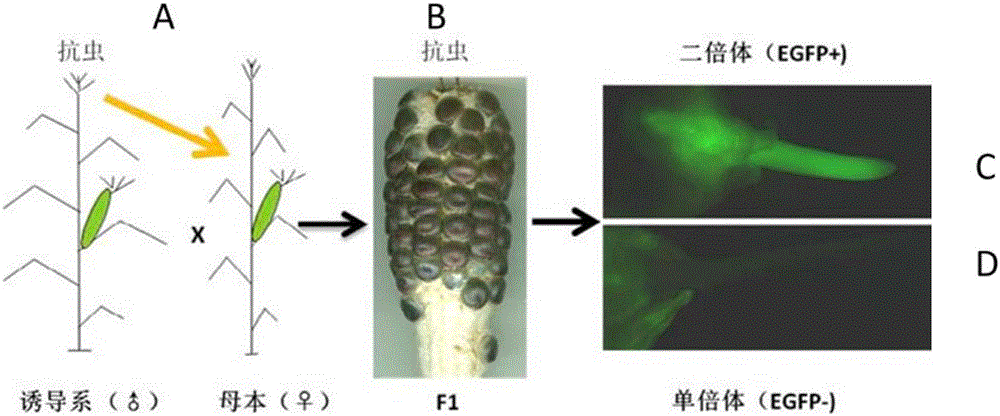New corn haploid inducing line and applications thereof
A haploid inducible line and the technology of the inducible line, applied in the field of genetic engineering, can solve the problems of affecting the reproduction of the inducible line haploid induction, the lack of pigment expression in the parent material, the instability and accuracy of the system, etc. management, ease of large-scale production, and the effect of improving the quality of growth and development
- Summary
- Abstract
- Description
- Claims
- Application Information
AI Technical Summary
Problems solved by technology
Method used
Image
Examples
example 1
[0055] Construction of Example 1 Transgenic Vector and Gene Transformation of Maize
[0056] The expression vector construction of EGFP / Bt / Bar is as follows figure 2 . The vector contains three gene expression cassettes: the expression of the EGFP gene is driven by the 2x35S promoter, the expression of the gene is enhanced by the AMV enhancer sequence (Datla et al. 1993), and the transcription of the gene is terminated by the NosT terminator; the expression of the Bt gene is driven by the 2x35S promoter , using the NosT terminator to terminate gene transcription; the expression of the herbicide resistance gene Bar was driven by the 2x35S promoter, and the NosT terminator was used to terminate gene transcription. The Bar gene was used as a marker for maize transformation screening.
[0057] The vector containing the EGFP / Bt / Bar expression cassette was transformed into Agrobacterium tumefaciens EHA101 strain (Hood et al., 1986) by freeze-thaw method (Weigel and Glazebrook, 200...
example 2
[0060] Example 2 Transfers the EGFP / Bt / Bar gene into the maize haploid induction line RWS by backcrossing and selfing
[0061]The transgenic maize (♂) expressing EGFP / Bt / Bar was crossed with the haploid inducible line RWS (♀) to produce the first hybrid F1; F1 was used as the male parent (♂) to be backcrossed to RWS (♀) to generate the first generation BC1; The BC1 individual expressing R1-nj and EGFP / Bt / Bar was backcrossed to RWS (♀) with this individual as the male parent (♂) to generate the second generation of backcross BC2; screening for expression of R1-nj and EGFP / Bt / Bar at the same time BC2 individual, and use this individual as the male parent (♂) to backcross to RWS (♀) to generate three generations of backcross BC3; screen BC3 individuals expressing R1-nj and EGFP / Bt / Bar at the same time and self-cross to produce BC3F1; screen Ten BC3F1 individuals expressing both R1-nj and EGFP / Bt / Bar were selfed (some of them were homozygous) to produce BC3F2 ( Figure 4 ). If t...
example 3
[0062] Example 3 detects the device for corn EGFP expression ( Figure 5 )
[0063] The detection of EGFP can generally be carried out under a fluorescent microscope or a fluorescent dissecting microscope, but the fluorescent microscope and dissecting microscope are expensive, not easy to carry, and the operation is complicated, which is not conducive to the large-scale detection of maize haploid. For the detection of EGFP expression in corn grains and seedlings, an LED flashlight that produces ultraviolet excitation light can be used to irradiate the material expressing EGFP, and then observe and screen with the naked eye through ultraviolet-proof glasses in a dark room.
PUM
 Login to View More
Login to View More Abstract
Description
Claims
Application Information
 Login to View More
Login to View More - R&D
- Intellectual Property
- Life Sciences
- Materials
- Tech Scout
- Unparalleled Data Quality
- Higher Quality Content
- 60% Fewer Hallucinations
Browse by: Latest US Patents, China's latest patents, Technical Efficacy Thesaurus, Application Domain, Technology Topic, Popular Technical Reports.
© 2025 PatSnap. All rights reserved.Legal|Privacy policy|Modern Slavery Act Transparency Statement|Sitemap|About US| Contact US: help@patsnap.com



